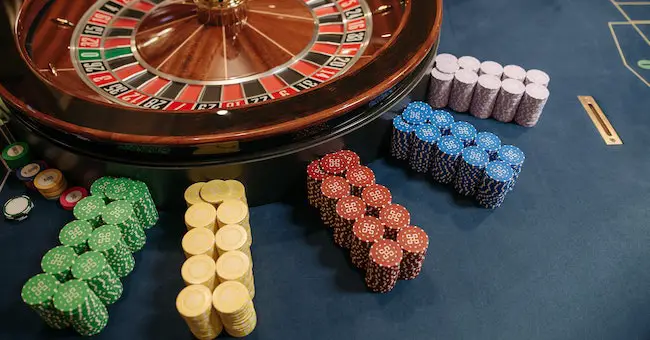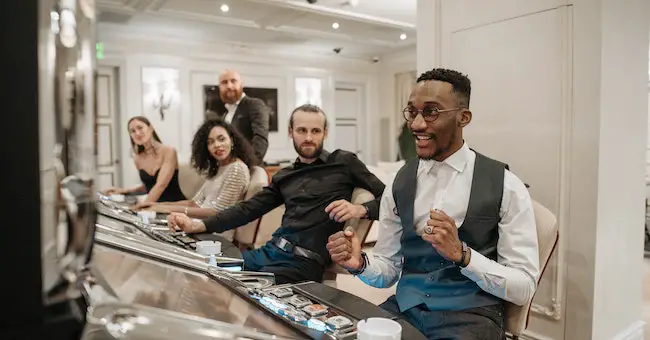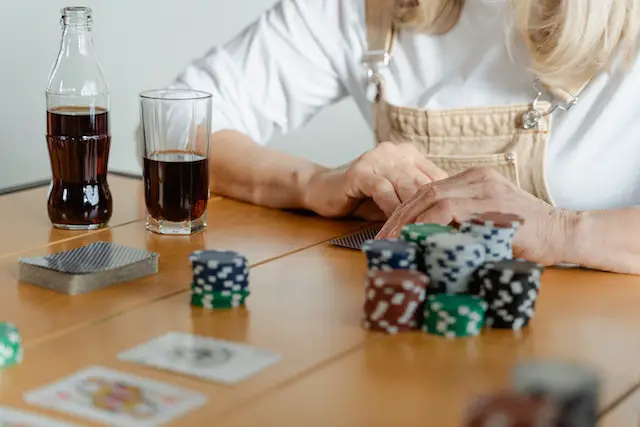Is Casino Royale In Black And White?
Luckily, Martin Campbell was picked to be the director of Casino Royale. He decided to shoot the opening scene entirely in black and white. Certain portions of the Bond film have never been shot in black and white.
The Cinematic Spectacle Of Casino Royale

Casino Royale, released in 2006, started a new era in the James Bond franchise. Martin Campbell was the director of the movie, which starred Daniel Craig as the renowned MI6 agent. The film offered a new perspective on the iconic character, revitalizing the franchise and attracting global audiences.
With its compelling story, breathtaking visuals, and stunning acting, Casino Royale became a cinematic experience that made an impression on the world of spy movies. We will examine the numerous factors contributing to the film’s success and analyze why it is an important and adored entry within the Bond franchise.
The Rebirth of Bond: The most notable feature in Casino Royale was the reinvention of the James Bond character. Daniel Craig’s performance brought a new level of grit and authenticity to the character by eschewing his previous counterparts’ elegant and elegant manner. Bond was transformed into an incredibly flawed and complex character, allowing audiences to bond with him more personally.
Craig’s physicality and intense performance gave a raw and physical character to the action scenes and made them more exciting. The fresh take on Bond created the foundation for a new approach to the franchise, popular with long-time Bond fans and a younger generation.
A Riveting Storyline: The center of Casino Royale lies in a compelling and well-constructed storyline. The film transports us to when we first began Bond’s career, looking at his first assignment as Agent 00. Bond’s task is to stop Le Chiffre, a terrorist financier, in a high-stakes poker game.
The stakes aren’t just financial; they also affect the entire world. The story unfolds with a perfectly balanced mix of intrigue, suspense, and character growth. The story is faithful to the novel by Ian Fleming and incorporates contemporary elements that are relevant and appealing to modern readers.
Breathtaking Action Sequences: Casino Royale raised the bar for action sequences within Bond’s Bond franchise. The film embraced the audience with a more realistic and grounded approach to action, focusing on real-life actions instead of CGI spectacle. The parkour chase sequence at the movie’s opening, where a bomb maker chases Bond on the construction site, is a memorable scene that demonstrates the film’s dedication to thrilling and intense action.
The showdown against the sinking of a building in Venice is another stunning scene that keeps the audience at the top of their chairs. These action scenes, combined with the film’s breathtaking cinematography, help to establish the film’s status as a cinematic experience.
A Captivating Bond Girl: Every Bond film features an unforgettable Bond girl, so Casino Royale is no exception. Eva Green’s portrayal of Vesper Lynd, a smart and mysterious Treasury agent, gives the plot depth and deeper meaning. The chemistry between Vesper and Bond is evident, and their relationship is an integral element of the story.
The performance of Green as Vesper received praise from critics, and her character is iconic in Bond’s Bond franchise. The presence of Vesper is a highlight in the film, bringing emotional resonance to the high-risk action.
Intriguing Villain: Casino Royale introduces audiences to Le Chiffre, a menacing and determined villain played by Mads Mikkelsen. Le Chiffre is not a typical Bond villain. He lacks extravagant schemes and elaborate hideaways. However, he is a quiet and subtle menace. Mikkelsen’s portrayal adds authenticity and depth to Le Chiffre, which makes Le Chiffre a formidable opponent for Bond.
The poker scenes between Bond and Le Chiffre are thrilling and captivating, with high stakes and psychological tension. Le Chiffre’s appearance as a formidable and intriguing antagonist enhances the overall visual spectacle of the feature.
Casino Royale’s Visual Style

Casino Royale, released in 2006, not only re-energized the James Bond franchise but also provided a stunning, visually stunning style that captured the attention of audiences worldwide. Martin Campbell, the film’s producer, gave it a distinctive visual look that enhanced the cinematic experience and contributed significantly to its overall success. We’ll explore the many elements of the style that made it an outstanding film within the Bond franchise.
Elegant Production Design: One of the most important aspects that contributed to the attraction and influenced the visual appeal of Casino Royale was its elegant production design. From the lavish interiors of the poker rooms to the extravagant setting of exotic locations, each detail was carefully crafted.
Under the direction of Peter Lamont, the team behind the production design created a lavish and refined world that reflected the extravagant lifestyle of James Bond. The attention to detail evident in the set’s design gave depth and authenticity to the film, engulfing viewers in the glitzy world of spying.
Stunning Cinematography: Casino Royale featured breathtaking cinematography, which enhanced the impact of the film’s visuals. Phil , the director of photography, masterfully captured the splendor of the locales and the vigor of the action scenes. The film showed various styles and visuals, ranging from the warm beach of the Bahamas to the dark and somber atmosphere of the casino’s interiors.
The cinematography was a play on the effects of shadow and light, creating stunning compositions that added artistic flair to the movie. The stunning frame and camera movements gave an element of energy to the narrative.
Aesthetic Color Palette: The colors of Casino Royale were a key element in the development of its visual style. The film used a mix of muted and vibrant shades to convey various moods and scenes. In the lavish casino scenes, deep and rich hues like gold and red dominate the frame, representing abundance and wealth.
Contrastingly, the more ferocious and violent action sequences were distinguished by cool tones, highlighting the high-risk character of Bond’s mission. The use of color did not just enhance the film’s visual impact. Still, it helped to tell the story by creating an aesthetic language that amplified the emotional intensity of each scene.
Sleek Costume Design: The costumes used in Casino Royale were carefully selected to reflect the elegance of the actors. Lindy Hemming is the costume designer. She created a costume that seamlessly melded style and practicality. James Bond’s iconic suits, designed to perfection, were a perfect example of class and sophistication.
The Bond girls’ clothes varied from elegant evening gowns to practical and modern outfits, reflecting their distinct characters and roles in the film. The costumes did not just contribute to the aesthetic attraction of the film but also contributed to the definition of the characters, giving dimension and depth to their depiction.
Dynamic Editing: The editing process in Casino Royale played a significant part in creating a captivating experience. Stuart Baird, the editor, created sequences with skill that maintained a sense of tension and energy throughout the entire film. The fast-paced action scenes were meticulously edited to enhance the effect of the stunts and keep the audience excited.
On the contrary, the poker sequences were carefully edited to show the excitement and rigor of the sport. Its seamless transitions among various sequences and exact timing of cuts gave a lively quality to the narrative that kept the viewers interested in the story.
The Legacy Of Casino Royale’s Visual Identity

The film was released in 2006. Casino Royale revived its place within the James Bond franchise. It established a distinct visual identity that had a lasting impression on the franchise and the genre of spy films overall. Martin Campbell, who also produced the movie, used a distinctive visual aesthetic that combined grittiness, elegance, and a contemporary slant. We will examine the many aspects of the film’s visual identity that helped define its legacy and influenced the following Bond films.
A New Era of Realism: One of the most distinctive aspects of the visual identity of Casino Royale was the departure from the fantastical and extravagant elements that had been prevalent in prior Bond films. The film adopted an empathetic and grounded approach to its narrative and visual presentation.
This change toward realist storytelling was evident in the film’s cinematography, product design, and costume choices. The decision to depict Bond as vulnerable and flawed also added to the feeling of authenticity. It also laid the foundation for a new generation of Bond films based on authenticity and gritty action.
Cinematic Excellence in Action Sequences: Casino Royale set a new standard for action sequences in the Bond franchise. Its well-executed and choreographed action set pieces reflected the film’s aesthetic. The action scenes in Casino Royale stood out for their authenticity, physicality, and unrestrained energy, from the suspenseful chase at the beginning of the movie to the tense hand-to-hand combat scenes. The visual style of these scenes was based on practical stunts and limited use of CGI to enhance the viewer’s involvement in the film’s world and the effect of the actions.
An Emphasis on Practical Effects: As a result of its commitment to realism, Casino Royale placed a strong accent on the practical, which later became the mainstay of its aesthetic. From the real-life actions and explosive results to the use of real locations and sets, the film aimed to create a genuine, real-life experience for its viewers. The emphasis on practicality boosted the film’s visual appeal and added a layer of authenticity. It also increased the sensation of danger and suspense.
Visual Storytelling with Lights and Composition: The distinctive visual style that characterizes Casino Royale was further defined by the skillful use of composition and lighting to increase the story’s impact. The film utilized a variety of lighting techniques that conveyed mood and ambiance. From the harsh and dark lighting of dramatic and tense scenes to the bright and warm lighting of lighter moments, the lighting decisions in the film effectively conveyed the emotion and themes of every scene.
In addition, the arrangement of the shots was meticulously designed to visually convey the character’s dynamics, tension, and narrative development. The visual storytelling via lighting and composition was a major factor in the film’s engaging and immersive cinematic experience.
A Modern Aesthetic: The film’s visual identity was based on an updated aesthetic that reflected the modern aesthetics of the day. The film utilized simple and sleek design elements, especially in the production design and the costumes. The locations, whether lavish casino interiors or exotic locations, featured clean lines, contemporary design, and a muted color palette.
The costumes were modern and included Bond’s stylish suits as well as Bond’s sleek suits and the Bond girls’ stylish clothes. The modern style gave an updated and fresh look to the movie’s aesthetic identity, connecting with viewers while setting a new benchmark in the Bond franchise.
Colorful Moments In Casino Royale

Casino Royale, released in 2006, did not simply mark a fresh start to the James Bond franchise but also featured visually stunning and vibrant moments that brought richness and elegance to the audience. Martin Campbell directed the film, which featured a vibrant palette that enriched movie-going experiences and created an unforgettable impression on the viewers. We will examine the numerous vibrant moments in Casino Royale that helped to create its visual appeal and narrative.
Exotic Locations: One of the best features of Casino Royale is the inclusion of exotic locations filled with vivid hues. From the sun-soaked beaches in the Bahamas to the busy streets of Montenegro, the film took viewers to stunning settings. The vivid blues of the Caribbean Sea, the warmth and golden tones of sandy beaches, and the lush colors of lush scenery provided the movie’s visual majesty. Contrasting the vivid hues of the locales with the sad and dangerous world of espionage made for an intriguing visual contrast.
Casino Interiors: The lavish casino interiors of Casino Royale were a feast for the eyes, brimming with vivid colors and intricate and detailed details. The extravagant gambling establishments, like Casino Royale in Montenegro, displayed a sense of grandeur and class. The deep reds, rich blues, and glistening gold in the interiors created an atmosphere of luxury and extravagance. The bright patrons’ costumes and the extravagant lighting design added to the visual appeal, making casinos visually stunning and absorbing.
Fashion and Style: Casino Royale showcased various stylish and vibrant costumes that brought flair and interest to the movie. From James Bond’s exquisitely dressed tuxedos to the stunning evening gowns the Bond girls wore, the fashion choices were striking and captivating. The costumes were adorned with various hues, from bright and vibrant shades to subtle and sophisticated shades that reflected the personalities of the characters as well as the mood of the scenes. The vibrant costumes enhanced the visuals and contributed to the development of characters and world-building in the film.
Title Sequence: The opening sequence of Casino Royale was a dazzling display of artistry and color. It was designed by Daniel Kleinman; the sequence included vibrant and abstract images intricately integrated into the movie’s plot. The vibrant interaction of color, paired with the stylized animations, made for a visually stunning opening that established the film’s mood. The vivid visuals of the title sequence didn’t just serve as an aesthetic treat; they conveyed the themes of danger, espionage, and seduction.
Action Set Pieces: Although Casino Royale primarily embraced a more grounded and realistic style, it also featured exciting action scenes filled with flashes of vibrant color. Whether it was the harrowing chase scene on the construction site at the opening of the film or the dramatic finale of the sinking of a building in Venice, the action sequences featured visually captivating moments. The contrast of vivid colors with intense and gritty action produced a visually thrilling and unforgettable experience for viewers.
Emotional Impact: The color wasn’t only employed for spectacle purposes during Casino Royale, but it also conveyed emotion and triggered specific moods. The film used color metaphors to increase the emotions in specific scenes. For example, the romantic and warm colors in Bond’s scenes with Vesper Lynd emphasize their blossoming relationship. In contrast, more cold and dark colors were utilized in scenes of conflict and betrayal, which heightened the stakes for emotional impact. Using color brought dimension and depth to the story, creating a more immersive and enjoyable cinematic experience.
FAQ’s
Does the whole Casino Royale come in black and white?
9 ‘Casino Royale’ (2006). In addition, Casino Royale takes us back to Bond before his transformation into 007, and the prologue was filmed in both black and white, highlighting the extent to which the earlier scenes are compared to other scenes in the film. Of course, everything else in the film is colored as you would expect from a modern-day 007 film.
Are there any James Bond films in black and white?
No, the only time a Bond film wasn’t in color was Casino Royale, and that’s the opening scene. The remainder of the film, as well as other films, are colored.
Was the very first James Bond movie in black and white?
Casino Royale (1954)
What was the reason behind Casino Royale’s opening in black and white?
Casino Royale Was Almost Done in Black and White; in addition to wishing Pierce Brosnan to reprise his role as the double agent, Tarantino wanted to shoot the film in the 1960s and shoot the film entirely in black and white. He was also unhappy about the choice of actor for the agent.
Are there any black and white James Bond movies?
While the official James Bond films have never been made in black and white, there have been some unofficial adaptations and parodies of the character that were shot in black and white. For example, “Casino Royale” (1967) is a non-Eon Productions spoof of James Bond and features a black and white sequence.
Why do people sometimes think “Casino Royale” is in black and white?
There could be a few reasons for the confusion. One possibility is that some promotional materials or still images from “Casino Royale” may have been released in black and white, which could have led to the misconception. Additionally, the black and white sequence in the 1967 film “Casino Royale” might be mistakenly associated with the 2006 film adaptation.
















